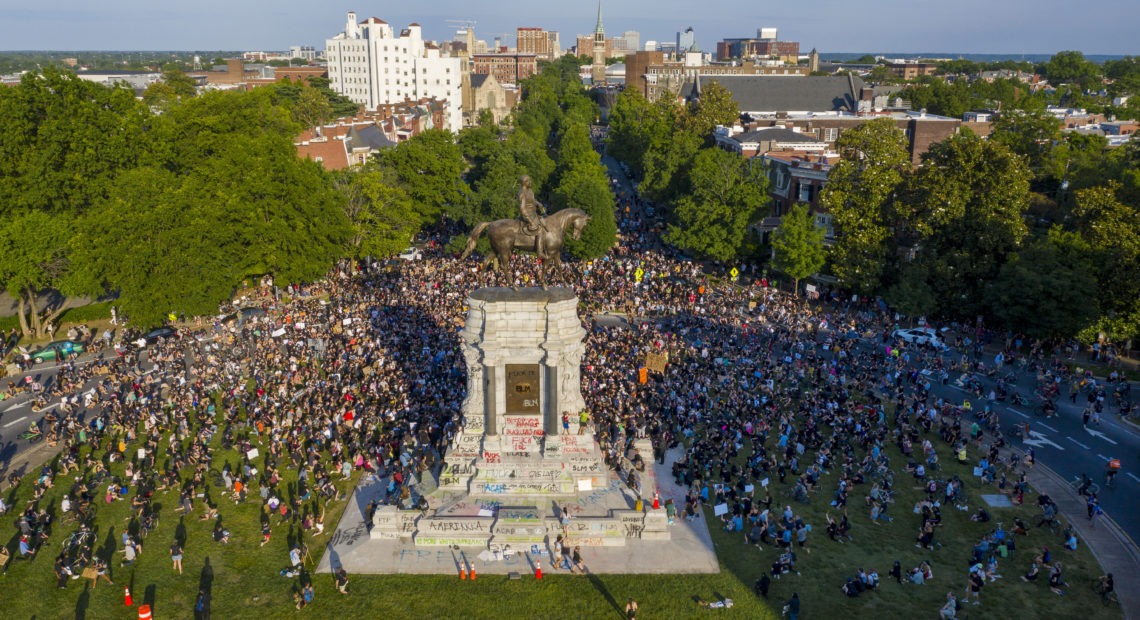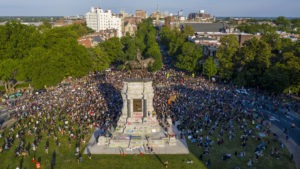
Large Robert E. Lee Statue In Richmond, Virginia Will Be Removed
BY BILL CHAPPELL
Virginia will remove a statue honoring Confederate Gen. Robert E. Lee in the city of Richmond “as soon as possible,” Gov. Ralph Northam announced Thursday.

A large group of protesters gathered around the statue of Confederate Gen. Robert E. Lee, on Tuesday in Richmond, Va. The crowd protesting police brutality chanted, “Tear it down.” CREDIT: Steve Helber/AP
“Today, we’re here to be honest about our past and talk about our future,” Northam said, adding: “We have to confront where we’ve been in order to shape where we’re going.”
The statue will be placed into storage, where it will remain until government leaders and the community can discuss its future, according to the governor.
“In Virginia, for more than 400 years, we have set high ideals about freedom and equality,” Northam said, “but we have fallen short of many of them.”
The statue will be removed from Richmond’s Monument Avenue, which is lined with effigies of Confederate generals. Of all the monuments, Lee’s looms the largest — and unlike the others, it is owned by the state, a six-story monument on a 100-foot island of land that the state also owns.
It’s up to Richmond, the Confederacy’s former capital, to decide what to do with the other statues; the city is in the process of determining what their fates will be.
“I know Richmond is going to do the right thing,” Northam said — prompting Richmond Mayor Levar Stoney, who was standing near Northam, to nod his head vigorously.
“It’s time to put an end to the Lost Cause and fully embrace the righteous cause,” Stoney said at Thursday’s news conference. “It’s time to replace the racist symbols of oppression and inequality — symbols that have literally dominated our landscape.”
“It’s time to heal, ladies and gentlemen,” he added.
The Confederate statues stoked anger over the weekend in Richmond, where there were large protests following the killing of George Floyd, a black man who died after a white Minneapolis police officer kneeled on his neck for an extended period of time. Protesters covered many of the statues’ bases with graffiti. Last night, an image of Floyd’s face was projected onto Lee’s statue.
“They represent a history of racism. They represent a history of sexism. They represent exactly what we’re fighting against. Why keep them up?” protester O.J. Knight, 25, told reporter Ben Paviour of member station VPM.
“Some conservatives condemned Northam’s plans,” Paviour says. “GOP state Sen. Amanda Chase — who is also running for governor — said this in a Facebook video posted last night: ‘It’s all about shoving this down people’s throats and erasing the history of the white people.’ ”
In response to news of the statue’s imminent removal, the Virginia Legislative Black Caucus called it “a step in the right direction” in the fight to roll back systemic racism and the “remaining vestiges of Jim Crow in our Commonwealth.”
The caucus also said the removal was long overdue.
“The Lee statue was a constant reminder to Black Virginians of racism, dehumanization, and hate that exists and was prevalent throughout our history,” said Caucus Chairman Lamont Bagby.
As he discussed the landmark moment, Northam noted the symbolism of putting Lee on a pedestal and the message it sends to African Americans.
He also acknowledged that the decision to dismantle the monument will be criticized by some, in Virginia and elsewhere, who say Lee was an honorable man and that the statue is part of history.
“Yes, that statue has been there for a long time. But it was wrong then, and it is wrong now — so we’re taking it down,” Northam said. “I know some will protest … I know many people will be angry.”
But he noted that when Virginians look at the state’s past, “We must do more than just talk about the future. We must take action. So I am directing the Department of General Services to remove the statue of Robert E. Lee as soon as possible.”
Northam also cited Virginia’s historic role in the American Revolution, including the famous cry, “Give me liberty, or give me death,” from Patrick Henry — who also served as a governor of Virginia.
“But there’s a whole lot more to the story,” Northam said, adding that the ideals of freedom and liberty “did not apply to everyone — not then, and not now.”
The Democratic governor noted that as the new country was taking shape, one of its largest slave markets was operating in Richmond, where men, women and children were sold for profit.
Northam survived calls for his resignation last year after a photo of a person wearing blackface standing next to another person wearing a Ku Klux Klan robe was spotted on his page in a medical school yearbook. The governor later told The Washington Post that he intended to make racial justice a focus of the rest of his term.
The monument to Lee is the latest controversial statue to be taken down during the furor over police brutality and racial injustice that is playing out in dozens of U.S. cities.
The city of Birmingham, Ala., took down an obelisk to Confederate troops earlier this week that had stood for more than a century. Philadelphia’s mayor also ordered the swift removal of a statue honoring Frank Rizzo, the former police commissioner and mayor — a divisive figure who rose to prominence during the late 1960s.
9(MDAyOTk4OTc0MDEyNzcxNDIzMTZjM2E3Zg004))















